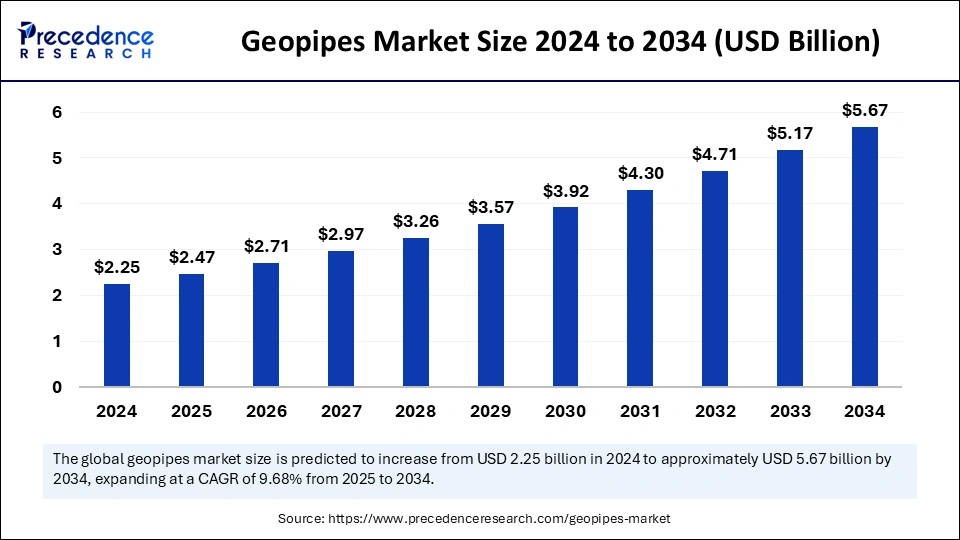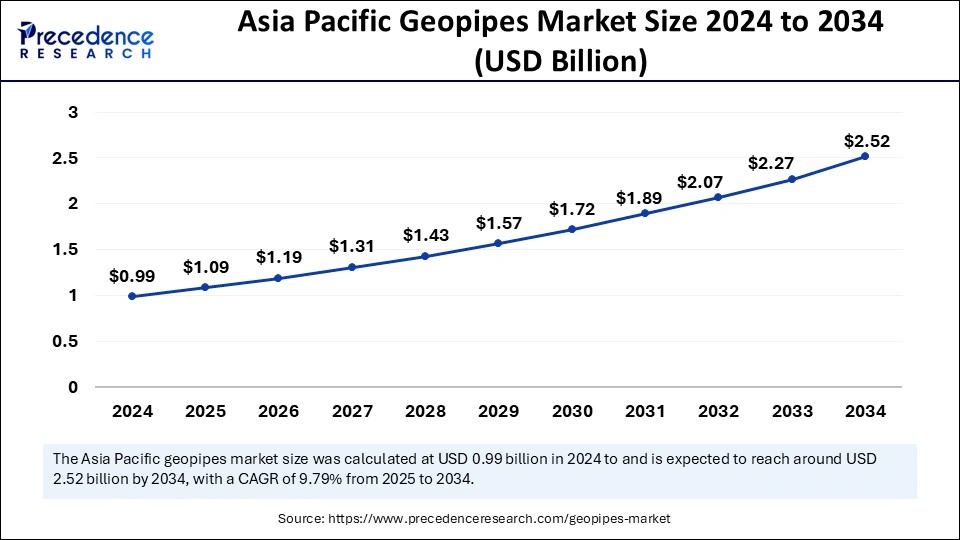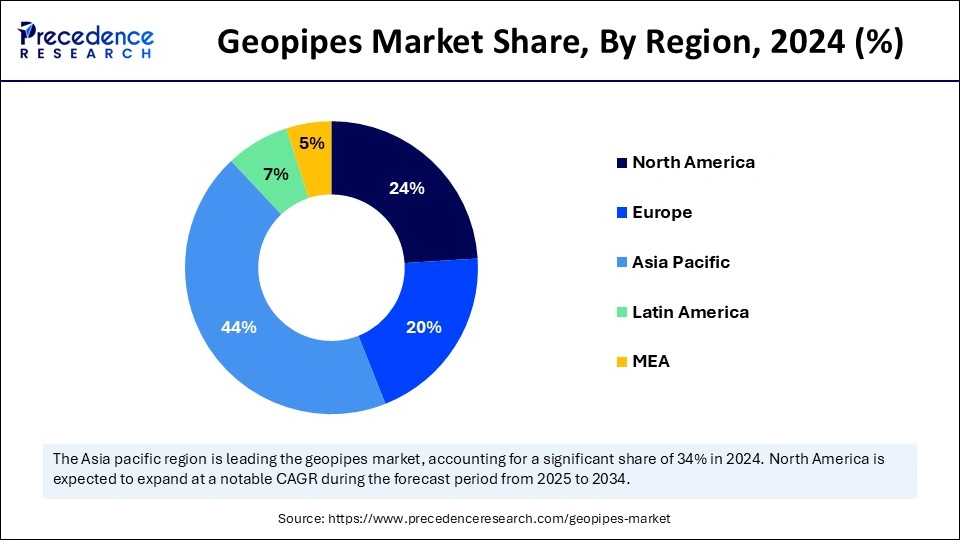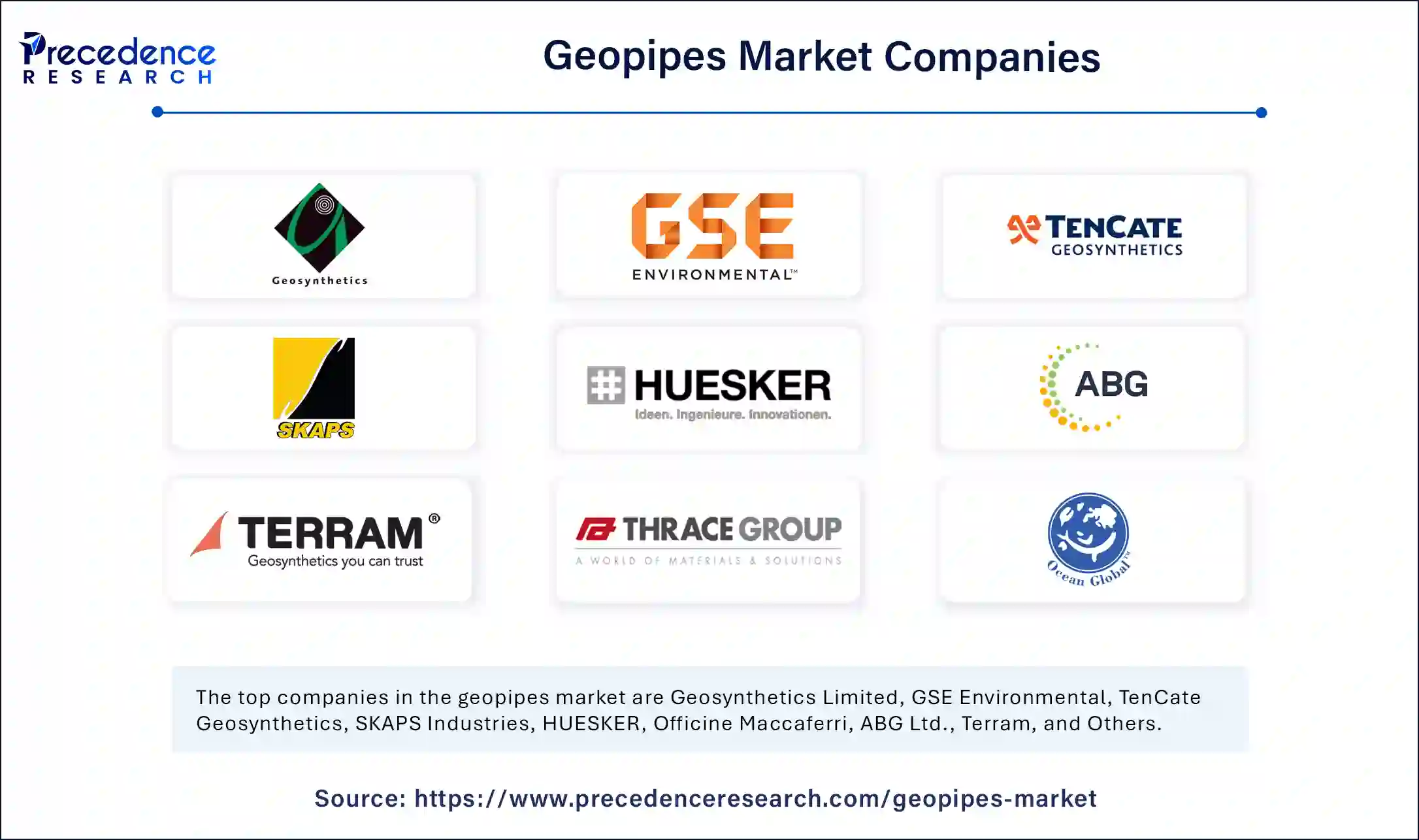The global geopipes market size is calculated at USD 2.47 billion in 2025 and is forecasted to reach around USD 5.67 billion by 2034, accelerating at a CAGR of 9.68% from 2025 to 2034. The Asia Pacific market size surpassed USD 990 million in 2024 and is expanding at a CAGR of 9.79% during the forecast period. The market sizing and forecasts are revenue-based (USD Million/Billion), with 2024 as the base year.
The global geopipes market size was estimated at USD 2.25 billion in 2024 and is predicted to increase from USD 2.47 billion in 2025 to approximately USD 5.67 billion by 2034, expanding at a CAGR of 9.68% from 2025 to 2034. The growth of the market is driven by increasing infrastructure development, rising demand for corrosion-resistant piping solutions, and expanding applications in water management and industrial sectors.

The geopipes industry experiences changes through artificial intelligence technology as it boosts production efficiency and helps in quality control. AI-driven predictive maintenance systems make it easier to identify potential failures in geopipes production, assisting manufacturers in improving product design and maintaining continuous operations. The production process improves through advanced machine learning, which analyzes several datasets to enhance polymer composition for creating stronger and more durable pipes. AI-powered sensors integrated into pipeline systems allow live measurements of structural health, reducing leaks. Furthermore, AI enables manufacturers to predict future demands and optimize supply chain management by managing inventory levels and logistics operations, reducing costs.
The Asia Pacific geopipes market size was exhibited at USD 0.99 mbllion in 2024 and is projected to be worth around USD 2.52 billion by 2034, growing at a CAGR of 9.79% from 2025 to 2034.

Asia Pacific led the geopipes market by capturing the largest share in 2024. This is mainly due to the rise in infrastructure development, rapid urbanization, and increased investments in water and sewage facilities. The adoption of geopipes increased across China, India, and Japan as these countries invested in enhancing their drainage, irrigation and transportation system networks. There is a high adoption of HDPE and PP pipes due to their long-lasting performance and resistance to corrosion while keeping costs affordable.
The government of China committed substantial resources to advance its smart water management, boosting the demand for piping solutions to transform urban drainage infrastructure for flood protection. Due to the country’s Belt and Road Initiative (BRI), the demand for durable pipeline infrastructure has increased. Moreover, urban sewerage systems in India benefit from the Smart Cities Mission as authorities actively integrate high-density polyethylene (HDPE) and polypropylene (PP) pipes for water distribution and sewerage applications. The expanding industrialization and rising construction activities within emerging economies such as Indonesia, Vietnam, and the Philippines fuel the market growth.

Europe is anticipated to witness the fastest growth during the forecast period. The European geopipes market growth is attributed to the rising investments in green building projects. European Union’s sustainability objectives and circular economy policies are boosting the demand for environment-friendly piping solutions, especially for drainage systems, sewage management, and industrial applications.
The French government supports climate-resilient infrastructure development, especially in flood-prone urban areas, boosting the need for durable geopipe solutions. Water utility companies throughout the UK are preferring PVC and HDPE geopipes as their preferred materials to improve efficiency and sustainability. The European government's goal of net-zero emissions by 2050 boosts the adoption of sustainable pipework materials in this region.
North America is expected to observe notable growth in the foreseeable future due to the growing investments in infrastructure pertaining to wastewater treatment facilities, stormwater systems, and energy systems. American and Canadian authorities are focusing on pipeline modernization, which drives the adoption of HDPE and PVC geopipes. Under the Bipartisan Infrastructure Law, the U.S. has designated billions of dollars for upgrading its water infrastructure, including drinking water and sewage systems. The Environmental Protection Agency (EPA) imposed strict pipe replacement regulations, boosting the demand for corrosion-resistant geopipes. The growing focus on establishing sustainable urban drainage systems that endorse durable polymer-based piping systems is expected to boost regional market growth in the coming years.
The worldwide geopipes market continues to expand at a rapid pace since businesses are seeking sustainable alternatives for infrastructure development. The corrosion-resistant and economical geopipes, made from high-density polyethylene (HDPE) and polyvinyl chloride (PVC) polymers, serve drainage system applications, sewage network installations, and industrial fluid transfer applications with their flexible design.
Advancements in polymer sciences have greatly boosted geopipe performance attributes, thus expanding applications in mining, agriculture, and oil & gas industries. The manufacturing sector now selects eco-friendly alternatives for aged infrastructure systems due to increasing environmental regulations alongside their commitment to reusable materials. The rising infrastructure development activities across the world are expected to boost the demand for geopipes in the coming years.
| Report Coverage | Details |
| Market Size by 2034 | USD 5.67 Billion |
| Market Size in 2025 | USD 2.47 Billion |
| Market Size in 2024 | USD 2.25 Billion |
| Market Growth Rate from 2025 to 2034 | CAGR of 9.68% |
| Dominating Region | Asia Pacific |
| Fastest Growing Region | North America |
| Base Year | 2024 |
| Forecast Period | 2025 to 2034 |
| Segments Covered | Product, Application, and Regions |
| Regions Covered | North America, Europe, Asia-Pacific, Latin America, and Middle East & Africa |
Increasing Infrastructure Development
Increasing infrastructure development around the world is one of the key factors driving the growth of the geopipes market. Geopipes find applications across various sectors, including water management, transportation, and oil & gas. Worldwide governments are focusing on establishing robust pipeline systems to enhance water delivery and sewage disposal and gas transportation infrastructure. Geopipes made from high-density polyethylene (HDPE) are suitable for infrastructure projects due to their high strength and corrosion-resistant properties. There is a strong emphasis on sustainable construction projects. Geopipes are environmentally friendly, making them suitable for sustainable construction. Stringent regulations regarding sustainability and energy efficiency further drive market growth.
Availability of Alternative Piping Solutions
The wide availability of alternative piping solutions hampers the growth of the geopipes market. Concrete and PVC pipes are preferred heavily over geopipes in particular infrastructure projects due to their economic benefits and excellent durability. The superior pressure resistance and structural capability of metallic or reinforced concrete pipes make them suitable for several applications. Their enhanced mechanical properties, durability, and ability to withstand harsh environmental conditions are key attributes boosting their adoption.
High Demand for Sustainable and Recyclable Materials
The rising demand for sustainable materials and recyclable materials is anticipated to create immense growth opportunities in the geopipes market. Businesses and consumers have become more aware of the environmental impact of construction materials. Thus, the demand for sustainable construction materials has increased. Geopipes made from recycled plastics offer a sustainable alternative, making them suitable for sustainable constructions. The governments and industries worldwide are also focusing on sustainable infrastructure development to reduce carbon emissions. This opens up new avenues for geopipes made from recycled plastics. Advancements in plastic polymers further enable the creation of recycled geopipe products, which makes them attractive for sustainable construction projects. The adoption of recyclable piping systems is expected to rise due to the rising focus on circular economy practices.
The high-density polyethylene (HDPE) segment dominated the geopipes market with the largest share in 2024. This is mainly due to its ability to operate under high-pressure conditions and withstand environmental stress cracking. HDPE pipes establish themselves as the optimal material for drainage and sewer applications, irrigation installations, and industrial processes. HDPE pipes are durable, flexible, and resistant to corrosion and chemicals, making them suitable for various applications. Furthermore, their lightweight design simplifies installation and decreases transportation expenses, bolstering the segment.
The polypropylene (PP) segment is expected to grow at the fastest rate in the market during the forecast period due to its high strength and resistance to chemicals and temperature variations. PP pipes are an ideal solution for applications with high exposure to harsh temperatures and chemicals. Furthermore, the rising demand for sustainable and efficient piping solutions is expected to boost the widespread implementation of PP pipes due to their recyclability.
The drainage & sewer systems segment held the largest share of the geopipes market in 2024 due to the rise in the need to develop more effective wastewater management and urban drainage systems. Rapid urbanization and industrialization boosted the need for sewage infrastructure systems that process higher waste flow. High-density polyethylene (HDPE) pipes became prominent for their superior attributes, including corrosion resistance, flexibility, and extended service lifetime.
These pipes work well for wastewater and stormwater delivery, handling demanding environmental circumstances and chemical-based applications. Moreover, less joint installation in HDPE piping systems leads to better system efficiency through reduced leak occurrences. As per the report published by the American Society of Civil Engineers (ASCE) in 2024, HDPE pipe networks require 40-60% fewer joints than concrete systems, which enhances performance and reduces expenses.
The irrigation & agriculture segment is anticipated to expand at the highest CAGR during the studied period, as agricultural practices prioritize water management systems that help supply water without affecting quality. The modern irrigation system depends heavily on geopipes, as these systems enable precise water distribution to agricultural fields. Farmers and agricultural planners use geopipes for their durability while offering resistance to environmental hazards and being easily installed without difficulty. The agricultural sector depends on dependable piping solutions. There is a high demand for cutting-edge irrigation techniques, including drip systems and sprinkler methods, which drives the demand for geopipes. The U.S. Government Accountability Office reported in 2025 that agricultural productivity needs efficient irrigation technologies and practices to address water scarcity issues.

In March 2025, REHAU launched the first 100% climate-neutral plastic sewer system. This innovative sewage pipe system is designed with a focus on the circular economy, contributing to significant emissions savings. Constructed from 100% recycled polymer and high-quality polypropylene, it allows for measurable CO2 reduction by utilizing sustainable and recyclable materials. “Our new polymer sewage system uniquely combines performance and sustainability,” said Steve. “With nevoPP, we offer the wastewater industry a reliable option on their path toward net zero, while maintaining the high standards.” He added, “At REHAU, we are dedicated to driving the transition to sustainable materials for businesses. Our latest innovation, nevoPP, exemplifies this commitment. By modernizing our production facilities, we continuously improve efficiency and ensure that sustainability remains at the core of our manufacturing processes.”
By Product
By Application
By Region
For inquiries regarding discounts, bulk purchases, or customization requests, please contact us at sales@precedenceresearch.com
No cookie-cutter, only authentic analysis – take the 1st step to become a Precedence Research client